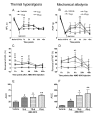The role of TRPV1 in different subtypes of dorsal root ganglion neurons in rat chronic inflammatory nociception induced by complete Freund's adjuvant
- PMID: 19055783
- PMCID: PMC2628345
- DOI: 10.1186/1744-8069-4-61
The role of TRPV1 in different subtypes of dorsal root ganglion neurons in rat chronic inflammatory nociception induced by complete Freund's adjuvant
Abstract
Background: The present study aims to investigate the role of transient receptor potential vanilloid 1 (TRPV1) in dorsal root ganglion (DRG) neurons in chronic pain including thermal hyperalgesia and mechanical allodynia. Chronic inflammatory nociception of rats was produced by intraplantar injection of complete Freund's adjuvant (CFA) and data was collected until day 28 following injection.
Results: Thermal hyperalgesia was evident from day 1 to day 28 with peak at day 7, while mechanical allodynia persisted from day 1 to day 14 and was greatest at day 7. Intrathecal administration of AMG 9810 at day 7, a selective TRPV1 antagonist, significantly reduced thermal hyperalgesia and mechanical allodynia. TRPV1 expression in DRG detected by Western blotting was increased relative to baseline throughout the observation period. Double labeling of TRPV1 with neuronal marker neurofilament 200 (NF200), calcitonin gene-related peptide (CGRP) or isolectin B4 (IB4) was used to distinguish different subtypes of DRG neurons. TRPV1 expression was increased in the medium-sized myelinated A fiber (NF200 positive) neurons and in small non-peptidergic (IB4 positive) neurons from day 1 to day 14 and was increased in small peptidergic (CGRP positive) neurons from day 1 to day 28.
Conclusion: TRPV1 expression increases in all three types of DRG neurons after CFA injection and plays a role in CFA-induced chronic inflammatory pain including thermal hyperalgesia and mechanical allodynia.
Figures




References
-
- Hayes P, Meadows HJ, Gunthorpe MJ, Harries MH, Duckworth DM, Cairns W, Harrison DC, Clarke CE, Ellington K, Prinjha RK, Barton AJ, Medhurst AD, Smith GD, Topp S, Murdock P, Sanger GJ, Terrett J, Jenkins O, Benham CD, Randall AD, Gloger IS, Davis JB. Cloning and functional expression of a human orthologue of rat vanilloid receptor-1. Pain. 2000;88:205–215. doi: 10.1016/S0304-3959(00)00353-5. - DOI - PubMed
-
- McIntyre P, McLatchie LM, Chambers A, Phillips E, Clarke M, Savidge J, Toms C, Peacock M, Shah K, Winter J, Weerasakera N, Webb M, Rang HP, Bevan S, James IF. Pharmacological differences between the human and rat vanilloid receptor 1 (VR1) Br J Pharmacol. 2001;132:1084–1094. doi: 10.1038/sj.bjp.0703918. - DOI - PMC - PubMed
-
- Szallasi A, Blumberg PM. Vanilloid (Capsaicin) receptors and mechanisms. Pharmacol Rev. 1999;51:159–212. - PubMed
Publication types
MeSH terms
Substances
LinkOut - more resources
Full Text Sources
Other Literature Sources
Medical
Research Materials

